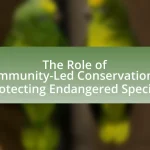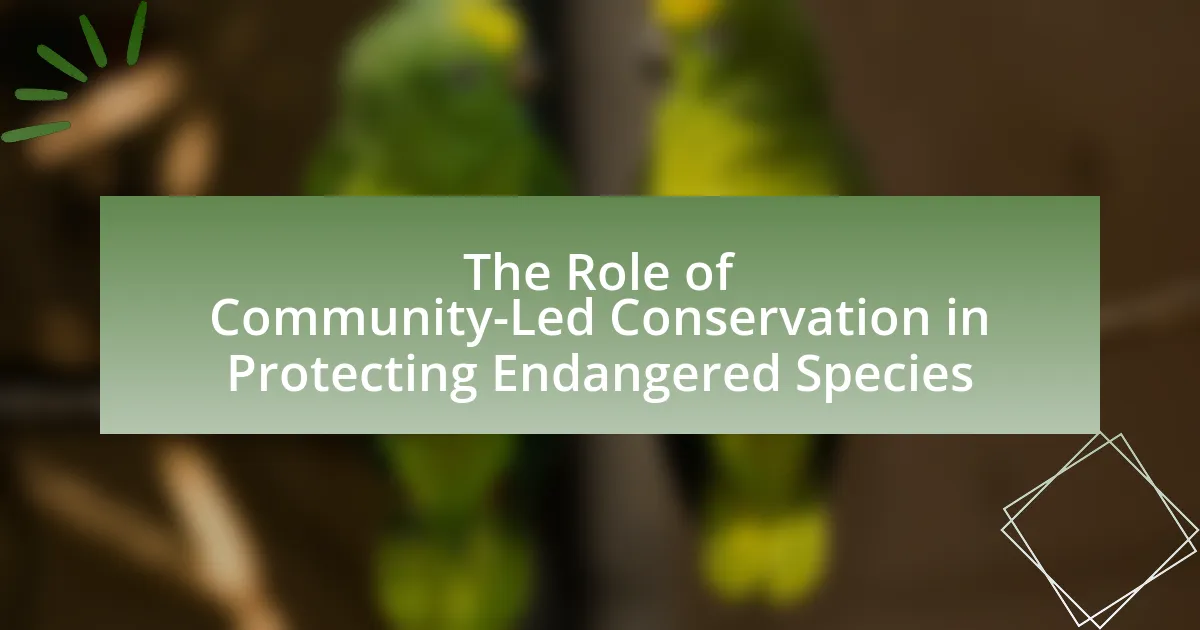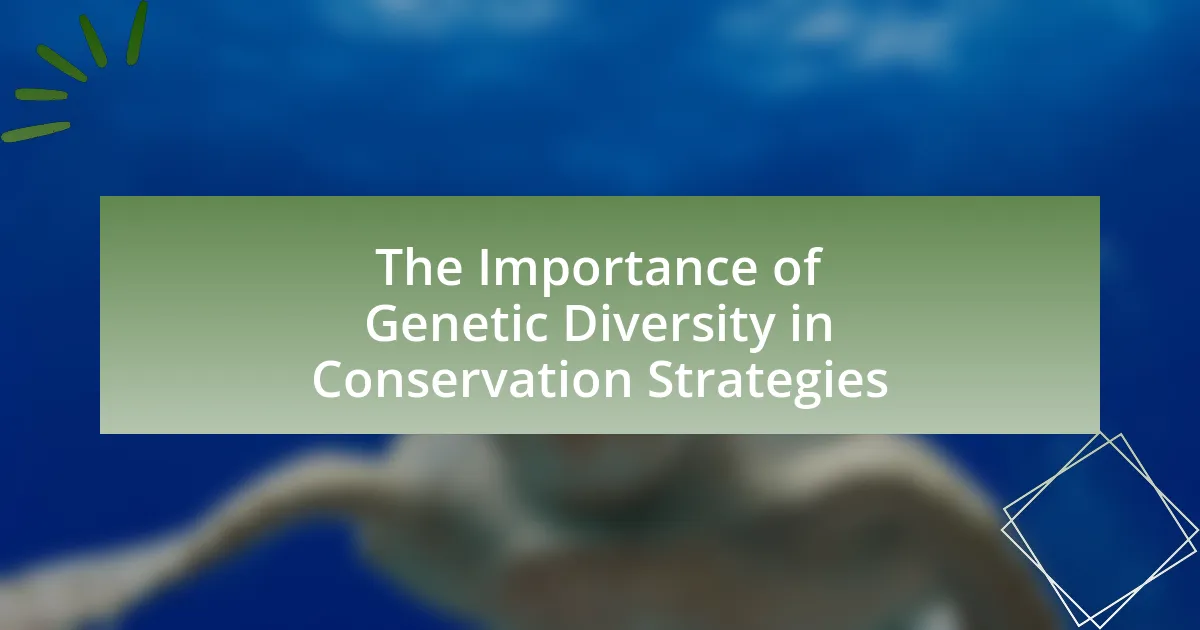The article examines the intersection of Indigenous rights and species protection, highlighting the critical role Indigenous peoples play in managing and conserving biodiversity on their traditional lands. It discusses how Indigenous communities possess traditional ecological knowledge that enhances conservation efforts, often resulting in higher biodiversity levels compared to other management practices. Key principles of Indigenous rights, such as self-determination and land rights, are explored in relation to environmental conservation, emphasizing the importance of integrating Indigenous perspectives into species protection initiatives. The article also addresses the challenges faced at this intersection, including conflicts between development and conservation, and outlines effective strategies for promoting Indigenous-led conservation efforts.

What is the Intersection of Indigenous Rights and Species Protection?
The intersection of Indigenous rights and species protection involves the recognition of Indigenous peoples’ rights to manage and protect their traditional lands and resources, which often include critical habitats for various species. Indigenous communities possess traditional ecological knowledge that is vital for biodiversity conservation, as evidenced by studies showing that Indigenous-managed lands often have higher biodiversity levels compared to other land management practices. For instance, research published in the journal “Nature” indicates that Indigenous territories cover about 22% of the Earth’s surface and are home to 80% of the world’s biodiversity, highlighting the crucial role Indigenous stewardship plays in species protection. This intersection emphasizes the need for collaborative approaches that respect Indigenous rights while promoting effective conservation strategies.
How do Indigenous rights relate to environmental conservation?
Indigenous rights are fundamentally linked to environmental conservation as they often encompass the stewardship of traditional lands and resources. Indigenous communities possess extensive ecological knowledge and sustainable practices that contribute to biodiversity preservation and ecosystem health. For instance, studies have shown that areas managed by Indigenous peoples have lower rates of deforestation and higher biodiversity compared to other regions. This relationship is recognized in international frameworks, such as the United Nations Declaration on the Rights of Indigenous Peoples, which emphasizes the importance of Indigenous land rights in achieving sustainable development and environmental protection.
What are the key principles of Indigenous rights?
The key principles of Indigenous rights include self-determination, land rights, cultural preservation, and participation in decision-making processes. Self-determination allows Indigenous peoples to govern themselves and make decisions about their own lives, as recognized in the United Nations Declaration on the Rights of Indigenous Peoples (UNDRIP). Land rights affirm Indigenous peoples’ ownership and stewardship of their ancestral territories, which is essential for their cultural identity and survival. Cultural preservation emphasizes the importance of maintaining and revitalizing Indigenous languages, traditions, and practices. Participation in decision-making processes ensures that Indigenous voices are included in policies affecting their communities and lands, aligning with international legal frameworks that support their rights.
How do these principles influence species protection efforts?
The principles of Indigenous rights significantly influence species protection efforts by integrating traditional ecological knowledge and cultural values into conservation strategies. Indigenous communities often possess a deep understanding of local ecosystems, which can enhance biodiversity conservation. For instance, the United Nations Declaration on the Rights of Indigenous Peoples emphasizes the importance of Indigenous participation in environmental decision-making, leading to more effective and culturally relevant conservation practices. Studies have shown that areas managed by Indigenous peoples often exhibit higher biodiversity levels, demonstrating the effectiveness of their stewardship in protecting species.
Why is species protection important for Indigenous communities?
Species protection is crucial for Indigenous communities because it safeguards their cultural identity and sustains their traditional livelihoods. Indigenous peoples often rely on specific species for food, medicine, and cultural practices, which are integral to their way of life. For instance, the loss of salmon populations has significantly impacted the cultural and economic practices of Indigenous groups in the Pacific Northwest, as salmon is not only a food source but also a central element of their cultural heritage. Protecting these species ensures the continuation of traditional knowledge and practices, which are vital for the community’s social structure and identity. Additionally, species protection aligns with Indigenous rights to land and resources, reinforcing their role as stewards of biodiversity and promoting ecological sustainability.
What role do traditional ecological knowledge and practices play?
Traditional ecological knowledge and practices play a crucial role in biodiversity conservation and sustainable resource management. Indigenous communities utilize this knowledge, which is based on centuries of observation and interaction with local ecosystems, to maintain ecological balance and promote species protection. For instance, studies have shown that areas managed by Indigenous peoples often exhibit higher biodiversity levels compared to those under conventional management practices. This is evidenced by research conducted by the United Nations Environment Programme, which highlights that Indigenous lands cover approximately 22% of the Earth’s surface and contain 80% of the planet’s biodiversity. Thus, integrating traditional ecological knowledge into modern conservation strategies enhances the effectiveness of species protection efforts.
How does species loss impact Indigenous cultures and livelihoods?
Species loss significantly impacts Indigenous cultures and livelihoods by disrupting traditional practices and diminishing access to vital resources. Indigenous communities often rely on specific species for food, medicine, and cultural rituals, which are integral to their identity and way of life. For instance, the decline of fish populations in the Pacific Northwest has affected the fishing practices of Indigenous tribes, leading to economic hardship and loss of cultural heritage tied to fishing traditions. Furthermore, the extinction of plant species used for medicinal purposes threatens the health and well-being of these communities, as traditional knowledge about these plants is often passed down through generations. This interdependence between species and Indigenous cultures highlights the critical need for species protection to sustain both ecological balance and cultural integrity.
What legal frameworks exist to support Indigenous rights in species protection?
Legal frameworks that support Indigenous rights in species protection include the United Nations Declaration on the Rights of Indigenous Peoples (UNDRIP), the Convention on Biological Diversity (CBD), and various national laws such as the Indian Self-Determination and Education Assistance Act in the United States. UNDRIP emphasizes the rights of Indigenous peoples to maintain their cultural practices and traditional knowledge related to biodiversity, while the CBD recognizes the role of Indigenous communities in conservation efforts. National laws often incorporate Indigenous rights into environmental protection policies, ensuring that Indigenous voices are included in decision-making processes regarding species protection. These frameworks collectively affirm the importance of Indigenous stewardship in biodiversity conservation and provide legal backing for their involvement in protecting species.
What international agreements address Indigenous rights and biodiversity?
International agreements that address Indigenous rights and biodiversity include the United Nations Declaration on the Rights of Indigenous Peoples (UNDRIP) and the Convention on Biological Diversity (CBD). UNDRIP, adopted in 2007, recognizes the rights of Indigenous peoples to maintain their cultural identities and traditional knowledge, which are crucial for biodiversity conservation. The CBD, established in 1992, emphasizes the importance of Indigenous knowledge in the sustainable use and conservation of biological diversity, promoting the involvement of Indigenous communities in decision-making processes related to biodiversity. These agreements collectively support the protection of Indigenous rights while fostering biodiversity conservation efforts.
How do national laws reflect these international commitments?
National laws reflect international commitments by incorporating principles and standards established in international treaties and agreements into domestic legal frameworks. For instance, countries that are signatories to the Convention on Biological Diversity integrate its objectives into national legislation, ensuring the protection of biodiversity and the rights of indigenous peoples. This is evident in laws that recognize indigenous land rights and promote sustainable resource management, aligning with the United Nations Declaration on the Rights of Indigenous Peoples, which emphasizes the importance of indigenous participation in decision-making processes regarding their lands and resources. Such legal frameworks demonstrate a commitment to uphold international standards while addressing local contexts and needs.
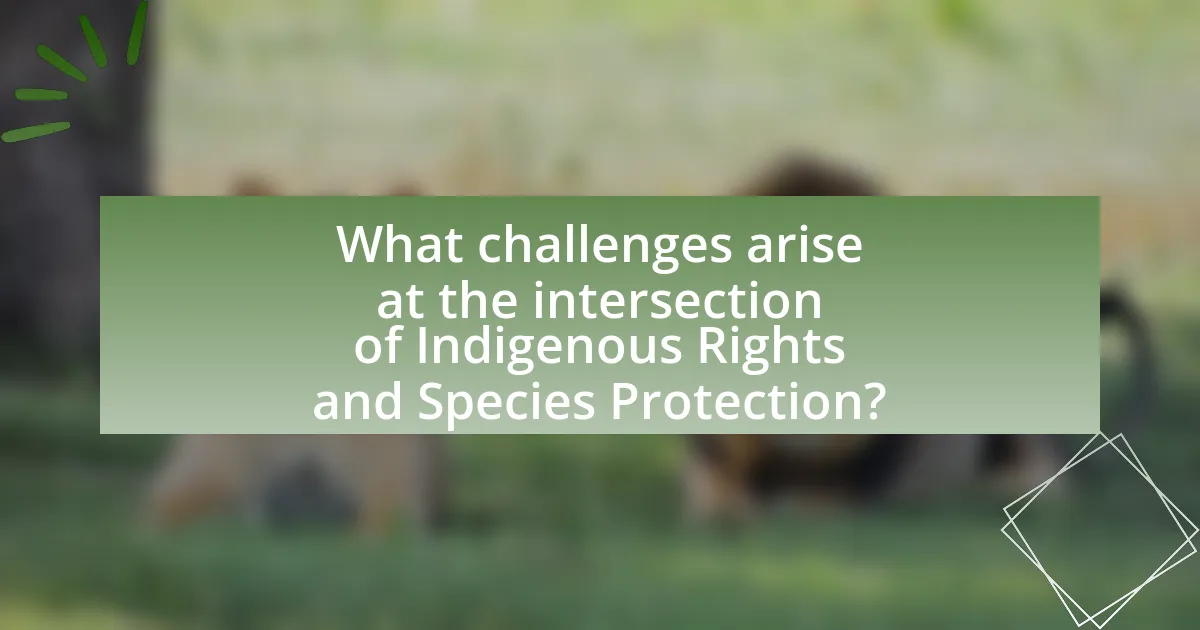
What challenges arise at the intersection of Indigenous Rights and Species Protection?
Challenges at the intersection of Indigenous Rights and Species Protection include conflicts over land use, differing cultural values regarding nature, and legal recognition of Indigenous sovereignty. Indigenous communities often prioritize traditional ecological knowledge and sustainable practices, while species protection laws may impose restrictions that limit their access to ancestral lands. For instance, the Endangered Species Act in the United States can lead to land designations that restrict Indigenous activities, creating tension between conservation efforts and Indigenous livelihoods. Additionally, the lack of meaningful consultation with Indigenous peoples in conservation planning can result in policies that do not reflect their rights or needs, undermining both species protection and Indigenous sovereignty.
What conflicts can occur between development and conservation efforts?
Conflicts between development and conservation efforts often arise from competing land use priorities. Development projects, such as infrastructure expansion or resource extraction, can lead to habitat destruction, threatening biodiversity and disrupting ecosystems. For instance, the construction of roads or urban areas can fragment habitats, making it difficult for species to thrive. Additionally, conservation initiatives may restrict land access for indigenous communities, leading to tensions over land rights and resource management. A notable example is the conflict surrounding the Amazon rainforest, where logging and agriculture threaten both the environment and the rights of indigenous peoples who depend on these lands for their livelihoods. These conflicts highlight the need for integrated approaches that balance development goals with conservation objectives.
How do economic interests clash with Indigenous land rights?
Economic interests often clash with Indigenous land rights when development projects, such as mining, logging, or agriculture, encroach on territories traditionally owned or used by Indigenous peoples. These projects can lead to environmental degradation, loss of biodiversity, and disruption of cultural practices, which are integral to Indigenous identities. For instance, the 2016 protests against the Dakota Access Pipeline highlighted how economic development initiatives can threaten sacred lands and water sources, leading to significant opposition from Indigenous communities. Additionally, legal frameworks in many countries often prioritize economic growth over Indigenous land claims, resulting in conflicts that undermine the rights and sovereignty of Indigenous populations.
What are the consequences of ignoring Indigenous voices in conservation?
Ignoring Indigenous voices in conservation leads to ineffective management of ecosystems and loss of biodiversity. Indigenous communities possess traditional ecological knowledge that is crucial for sustainable practices and understanding local ecosystems. For instance, studies have shown that areas managed by Indigenous peoples often have higher biodiversity and better conservation outcomes compared to those without their involvement. Furthermore, neglecting Indigenous perspectives can result in social injustices, eroding trust and cooperation between conservation organizations and local communities, ultimately hindering conservation efforts.
How can Indigenous communities advocate for their rights in species protection?
Indigenous communities can advocate for their rights in species protection by leveraging legal frameworks, engaging in collaborative management, and utilizing traditional ecological knowledge. Legal frameworks such as the United Nations Declaration on the Rights of Indigenous Peoples (UNDRIP) provide a basis for Indigenous rights to land and resources, which are crucial for species protection. Collaborative management initiatives, where Indigenous communities partner with governmental and environmental organizations, allow for the integration of Indigenous perspectives in conservation efforts. Furthermore, traditional ecological knowledge, which encompasses centuries of understanding local ecosystems, can inform sustainable practices and enhance biodiversity conservation. These strategies collectively empower Indigenous communities to assert their rights and contribute effectively to species protection.
What strategies have been effective in promoting Indigenous-led conservation?
Effective strategies for promoting Indigenous-led conservation include recognizing and formalizing Indigenous land rights, integrating traditional ecological knowledge into conservation practices, and fostering partnerships between Indigenous communities and governmental or non-governmental organizations. Research shows that when Indigenous land rights are legally recognized, it leads to better biodiversity outcomes; for instance, a study published in “Nature” by Benner et al. (2020) found that Indigenous-managed lands have lower deforestation rates compared to non-Indigenous areas. Additionally, incorporating traditional ecological knowledge enhances conservation efforts by providing insights into sustainable practices that have been used for generations. Collaborative partnerships empower Indigenous communities, ensuring they have a voice in decision-making processes related to conservation, which has been shown to improve the effectiveness of conservation initiatives.
How can partnerships between Indigenous groups and conservation organizations be strengthened?
Partnerships between Indigenous groups and conservation organizations can be strengthened through mutual respect, shared decision-making, and integrating traditional ecological knowledge into conservation practices. Establishing frameworks that prioritize Indigenous rights and governance ensures that Indigenous communities have a significant role in conservation efforts. For instance, the United Nations Declaration on the Rights of Indigenous Peoples emphasizes the importance of Indigenous participation in environmental decision-making, which can lead to more effective conservation outcomes. Collaborative projects that incorporate Indigenous knowledge have shown success in biodiversity preservation, as evidenced by initiatives like the Indigenous Guardians program in Canada, which empowers Indigenous communities to manage their lands and resources effectively.
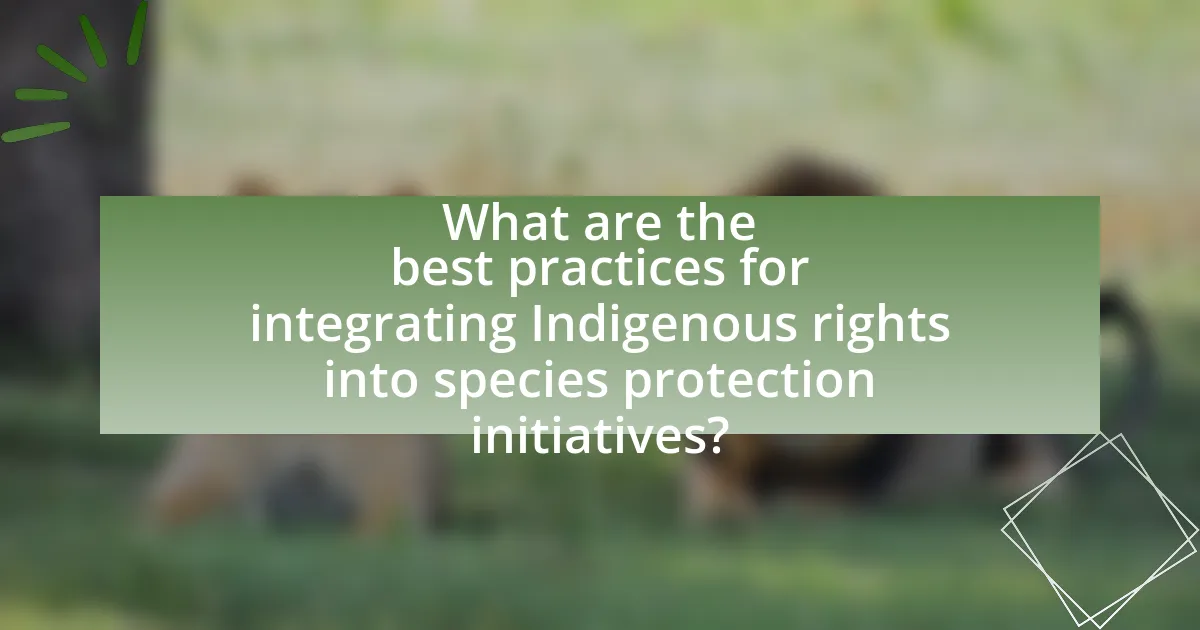
What are the best practices for integrating Indigenous rights into species protection initiatives?
The best practices for integrating Indigenous rights into species protection initiatives include ensuring meaningful consultation with Indigenous communities, recognizing their traditional ecological knowledge, and incorporating Indigenous governance systems into conservation strategies. Meaningful consultation allows Indigenous peoples to actively participate in decision-making processes, ensuring their rights and perspectives are respected. Recognizing traditional ecological knowledge acknowledges the deep understanding Indigenous communities have of local ecosystems, which can enhance species protection efforts. Additionally, incorporating Indigenous governance systems respects their authority and practices, leading to more effective and culturally appropriate conservation outcomes. These practices are supported by frameworks such as the United Nations Declaration on the Rights of Indigenous Peoples, which emphasizes the importance of Indigenous participation in matters affecting their lands and resources.
How can policymakers ensure Indigenous participation in conservation planning?
Policymakers can ensure Indigenous participation in conservation planning by actively involving Indigenous communities in decision-making processes and recognizing their rights to land and resources. This can be achieved through the establishment of co-management agreements that empower Indigenous peoples to share authority and responsibility in conservation efforts. For instance, the United Nations Declaration on the Rights of Indigenous Peoples emphasizes the importance of obtaining free, prior, and informed consent from Indigenous communities before undertaking projects that affect their lands. Additionally, successful case studies, such as the collaborative management of national parks in Australia, demonstrate that integrating Indigenous knowledge and practices leads to more effective conservation outcomes.
What frameworks support collaborative management of natural resources?
Collaborative management of natural resources is supported by frameworks such as the Co-Management Framework, the Adaptive Collaborative Management approach, and the Integrated Resource Management model. These frameworks facilitate partnerships between Indigenous communities, government agencies, and other stakeholders, promoting shared decision-making and resource stewardship. For instance, the Co-Management Framework has been effectively implemented in various regions, allowing Indigenous peoples to participate actively in the governance of their traditional lands, which has been shown to enhance biodiversity conservation and sustainable resource use. Additionally, the Adaptive Collaborative Management approach emphasizes learning and adaptation in resource management, which is crucial for addressing the dynamic challenges posed by environmental changes.
How can cultural heritage be preserved alongside biodiversity efforts?
Cultural heritage can be preserved alongside biodiversity efforts by integrating traditional ecological knowledge into conservation strategies. Indigenous communities possess valuable insights about local ecosystems, which can enhance biodiversity management while respecting cultural practices. For instance, the incorporation of Indigenous land management techniques, such as controlled burns, has been shown to improve habitat health and species diversity, as evidenced by studies in Australia where Aboriginal fire management practices have led to increased biodiversity in various ecosystems. This collaborative approach not only safeguards cultural heritage but also fosters sustainable environmental stewardship, creating a symbiotic relationship between cultural preservation and biodiversity conservation.
What lessons can be learned from successful Indigenous-led conservation projects?
Successful Indigenous-led conservation projects demonstrate the importance of integrating traditional ecological knowledge with modern conservation practices. These projects often lead to more effective biodiversity outcomes, as Indigenous communities possess a deep understanding of local ecosystems developed over generations. For instance, the Akwesasne Mohawk Nation’s efforts in restoring the St. Lawrence River have shown that community involvement and traditional practices can significantly enhance habitat restoration and species recovery. Furthermore, these projects highlight the necessity of respecting Indigenous rights and governance, which fosters stronger partnerships and ensures sustainable management of natural resources. Evidence from the “Indigenous Guardians” program in Canada illustrates that when Indigenous peoples are empowered to manage their lands, there is a marked increase in the health of ecosystems and wildlife populations.
What are the key factors that contribute to their success?
The key factors that contribute to the success of initiatives at the intersection of Indigenous rights and species protection include strong collaboration between Indigenous communities and conservation organizations, legal recognition of Indigenous land rights, and the integration of traditional ecological knowledge into conservation practices. Collaborative efforts ensure that Indigenous voices are heard and respected, leading to more effective conservation strategies. Legal recognition of land rights empowers Indigenous communities to manage their territories sustainably, as seen in cases like the land rights victories in Canada, which have led to improved biodiversity outcomes. Furthermore, traditional ecological knowledge, which encompasses centuries of experience in land stewardship, enhances scientific approaches to species protection, as demonstrated by successful programs in Australia that incorporate Indigenous practices in managing natural resources.
How can these lessons be applied to future initiatives?
Lessons learned from the intersection of Indigenous rights and species protection can be applied to future initiatives by integrating Indigenous knowledge systems into conservation strategies. This approach recognizes the value of traditional ecological knowledge, which has been shown to enhance biodiversity outcomes, as evidenced by studies indicating that Indigenous-managed lands often exhibit higher levels of biodiversity compared to non-Indigenous lands. Furthermore, involving Indigenous communities in decision-making processes fosters collaboration and ensures that conservation efforts respect cultural values and land rights, leading to more sustainable and effective initiatives. For instance, the successful co-management of natural resources in various regions demonstrates that partnerships between Indigenous peoples and conservation organizations can yield positive environmental and social results.
What practical steps can individuals take to support Indigenous rights and species protection?
Individuals can support Indigenous rights and species protection by advocating for policies that recognize and uphold Indigenous land rights, as these rights are often linked to the conservation of biodiversity. Engaging in campaigns that promote the protection of Indigenous territories, such as the United Nations Declaration on the Rights of Indigenous Peoples, can help ensure that Indigenous communities have a voice in environmental decision-making. Additionally, individuals can support Indigenous-led conservation initiatives, which have been shown to be effective in preserving ecosystems, as evidenced by studies indicating that Indigenous-managed lands often have higher biodiversity levels. Volunteering with organizations that focus on both Indigenous rights and environmental protection can further amplify these efforts, creating a direct impact on both social justice and ecological sustainability.


